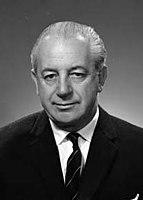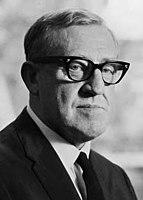| |||||||||||||||||||||||||||||||
All 124 seats of the Australian House of Representatives 63 seats were needed for a majority | |||||||||||||||||||||||||||||||
|---|---|---|---|---|---|---|---|---|---|---|---|---|---|---|---|---|---|---|---|---|---|---|---|---|---|---|---|---|---|---|---|
| |||||||||||||||||||||||||||||||
 Popular vote by state and territory with graphs indicating the number of seats won. As this is an IRV election, seat totals are not determined by popular vote by state or territory but instead via results in each electorate. | |||||||||||||||||||||||||||||||
| |||||||||||||||||||||||||||||||
The 1966 Australian federal election was held in Australia on 26 November 1966. All 124 seats in the House of Representatives were up for election. The incumbent Liberal–Country coalition government, led by Prime Minister Harold Holt, won an increased majority over the opposition Labor Party, led by Arthur Calwell. This was the first and only time the Liberal Party or any Political party won an 8th successive election.

Coalition
Liberal (61)
Country (21)
Opposition (41)
Labor (41)
Crossbench (6)
Independent (1)
Issues
Robert Menzies had retired from politics in January. His successor, former Treasurer Harold Holt, was stylish, debonair and popular with the electorate. He contrasted sharply with the much rougher figure of Arthur Calwell, who had already lost two elections. Calwell held to the beliefs that had been central to the last Labor Government of 1941–1949, many of which were seen as being old-fashioned in 1966; for example, he still defended socialism, the White Australia Policy, and nationalization. He also came across poorly on television compared to Holt, and looked and sounded older than his 70 years.
In addition, a strong economy and initial enthusiasm for Australia's involvement in the Vietnam War virtually guaranteed the Coalition another term. The Coalition campaigned with the slogan "Keep Australia secure and prosperous – play it safe".[1]
The election was a landslide win for the Coalition, which won twice as many seats as Labor. The Liberals arrived two seats short of a majority in their own right, the closest that the major non-Labor party had come to governing in its own right since adopting the Liberal banner. Holt's victory was greater than any of Menzies' eight victories, and resulted in the largest majority government in Australian history at the time. It was later seen as the electoral high point of both Holt's Prime Ministership and the 23 years of continuous Coalition rule.
Calwell retired to the backbench a month after the election and was succeeded by Deputy Labor leader Gough Whitlam.
Results
| Party | Votes | % | Swing | Seats | Change | ||
|---|---|---|---|---|---|---|---|
| Liberal–Country coalition | 2,853,890 | 49.98 | +3.94 | 82 | +10 | ||
| Liberal | 2,291,964 | 40.14 | +3.05 | 61 | +9 | ||
| Country | 561,926 | 9.84 | +0.90 | 21 | +1 | ||
| Labor | 2,282,834 | 39.98 | –5.49 | 41 | –9 | ||
| Democratic Labor | 417,411 | 7.31 | –0.13 | 0 | 0 | ||
| Liberal Reform | 49,610 | 0.87 | +0.87 | 0 | 0 | ||
| Communist | 23,056 | 0.40 | –0.19 | 0 | 0 | ||
| Independents | 82,948 | 1.45 | +0.98 | 1 | +1 | ||
| Total | 5,709,749 | 124 | +2 | ||||
| Two-party-preferred (estimated) | |||||||
| Liberal–Country coalition | WIN | 56.90 | +4.30 | 82 | +10 | ||
| Labor | 43.10 | −4.30 | 41 | −9 | |||
Independents: Sam Benson
Seats changing hands
| Seat | Pre-1966 | Swing | Post-1966 | ||||||
|---|---|---|---|---|---|---|---|---|---|
| Party | Member | Margin | Margin | Member | Party | ||||
| Adelaide, SA | Labor | Joe Sexton | 7.2 | 10.0 | 2.8 | Andrew Jones | Liberal | ||
| Barton, NSW | Labor | Len Reynolds | 0.7 | 2.9 | 2.2 | Bill Arthur | Liberal | ||
| Batman, Vic | Labor | Sam Benson | N/A | 8.7 | 7.8 | Sam Benson | Independent | ||
| Eden-Monaro, NSW | Labor | Allan Fraser | 2.7 | 3.4 | 0.7 | Dugald Munro | Liberal | ||
| Grey, SA | Labor | Jack Mortimer | 4.8 | 7.8 | 3.0 | Don Jessop | Liberal | ||
| Griffith, Qld | Labor | Wilfred Coutts | 5.8 | 6.9 | 1.1 | Don Cameron | Liberal | ||
| Herbert, Qld | Labor | Ted Harding | 3.2 | 4.3 | 1.1 | Robert Bonnett | Liberal | ||
| Hughes, NSW | Labor | Les Johnson | 2.7 | 4.7 | 2.0 | Don Dobie | Liberal | ||
| Kennedy, Qld | Labor | Bill Riordan | 13.5 | 15.0 | 1.5 | Bob Katter | Country | ||
| Kingston, SA | Labor | Pat Galvin | 4.5 | 12.7 | 8.2 | Kay Brownbill | Liberal | ||
| Lalor, Vic | Labor | Reg Pollard | 7.0 | 7.7 | 0.7 | Mervyn Lee | Liberal | ||
| Northern Territory, NT | Labor | Jock Nelson | 100.0 | 51.7 | 1.7 | Sam Calder | Country | ||
- Members in italics did not contest their seat at this election.
See also
- 1964 Australian Senate election
- 1967 Australian Senate election
- Candidates of the Australian federal election, 1966
- Members of the Australian House of Representatives, 1966–1969
Notes
References
- University of WA election results in Australia since 1890
- AEC 2PP vote
- Prior to 1984 the AEC did not undertake a full distribution of preferences for statistical purposes. The stored ballot papers for the 1983 election were put through this process prior to their destruction. Therefore, the figures from 1983 onwards show the actual result based on full distribution of preferences.

